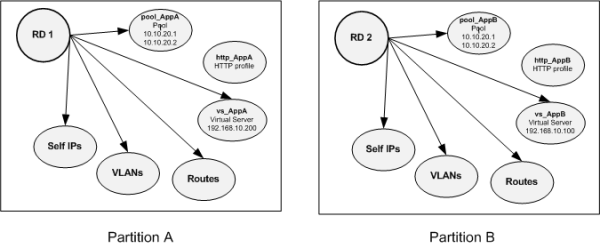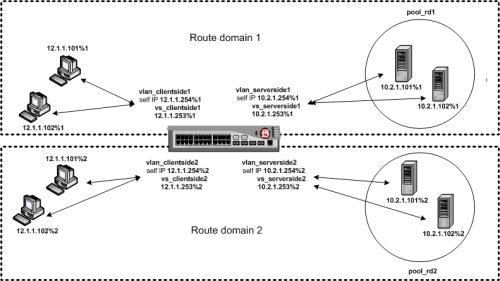A route domain is a configuration object that isolates network traffic for a particular application on the network.
Because route domains segment network traffic, you can assign the same IP address or subnet to multiple nodes on a network, provided that each instance of the IP address resides in a separate routing domain.
Benefits of route domains
Using the route domains feature of the BIG-IP system, you can provide hosting service for multiple customers by isolating each type of application traffic within a defined address space on the network.
With route domains, you can also use duplicate IP addresses on the network, provided that each of the duplicate addresses resides in a separate route domain and is isolated on the network through a separate VLAN. For example, if you are processing traffic for two different customers, you can create two separate route domains. The same node address (such as 10.0.10.1) can reside in each route domain, in the same pool or in different pools, and you can assign a different monitor to each of the two corresponding pool members.
Sample partitions with route domain objects
This illustration shows two route domain objects on a BIG-IP system, where each route domain corresponds to a separate customer, and thus resides in its own partition. Within each partition, the customer created the network objects and local traffic objects required for that customer's application (AppA or AppB).
 Sample partitions with route domains
Sample partitions with route domainsSample route domain deployment
 A sample route domain deployment
A sample route domain deploymentAbout route domain IDs
A route domain ID is a unique numerical identifier for a route domain. You can assign objects with IP addresses (such as self IP addresses, virtual addresses, pool members, and gateway addresses) to a route domain by appending the %ID to the IP address.
The format required for specifying a route domain ID in an object’s IP address is A.B.C.D%ID, where ID is the ID of the relevant route domain. For example, both the local traffic node object 10.10.10.30%2 and the pool member 10.10.10.30%2:80 pertain to route domain 2.
The BIG-IP system includes a default route domain with an ID of 0. If you do not explicitly create any route domains, all routes on the system pertain to route domain 0.
Traffic forwarding across route domains
You can create a parent-child relationship between two route domains, and configure strict isolation, to control the extent to which the BIG-IP system can forward traffic from one route domain to another.
About parent IDs
When you create a route domain, you can specify the ID of another route domain as the parent route domain. The parent ID identifies another route domain that the system can search to find a route if the system cannot find the route within the child route domain.
For example, using the BIG-IP Configuration utility, suppose you create route domain 1 and assign it a parent ID of 0. For traffic pertaining to route domain 1, the system looks within route domain 1 for a route for the specified destination. If no route is found, the system searches the routes in route domain 0.
By default, if the system finds no route in the parent route domain, the system searches the parent route domain’s parent, and so on, until the system finds either a match or a route domain with no parent. In the latter case, the system refrains from searching any other route domains to find a match, thus preventing the system from using a route from another route domain.

No comments:
Post a Comment